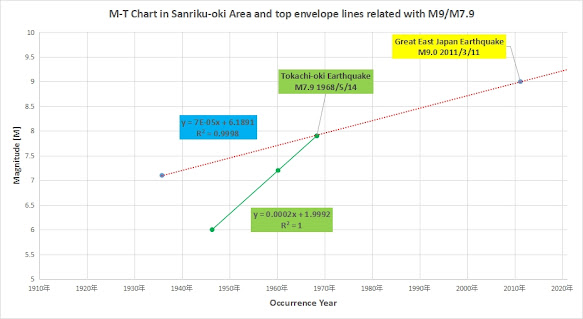The 6th "Accumulated value Chart" is for The Niigataken Chuetsu-oki Earthquake
(M6.8) in 2008 as below,
There were 2 other area peaks in 2011/2024. They were aftershocks of Great East Japan Earthquake (M9.0) and of Noto Peninsula Earthquake (M7.6) . Both of the epicenter are outside of this Area.The main depth was shifted from Yellow area (10km) to Orange area (20km) by The Niigataken Chuetsu-oki Earthquake (M6.8) in 2008. Then, by M9.0, it was turn back to Yellow area (10km) /Red area (1km). By M7.6, it has turn to Orange area (20km) /Red area (1km) .
The 7th "Accumulated value Chart" is for The Noto Hanto Earthquake (M6.9) in 2007, and the common as the first one is for Noto Peninsula Earthquake (M7.6) in 2024.
The 8th "Accumulated value Chart" is for The Mid Niigata prefecture Earthquake (M6.8) in 2004 as below,
After the peak of M6.8, there are 2 major peaks of Yellow area in 2007 and of Red area in 2011. They are aftershocks of The Noto Hanto Earthquake (M6.9) and of Great East Japan Earthquake (M9.0). There is no major peak for Noto Peninsula Earthquake in 2024 (M7.6) even though nearer and larger than The Noto Hanto Earthquake (M6.9) in 2007. Maybe, both M6.9 in 2007 and M9.0 in 2011 had taken away aftershocks before it. These Red Area peaks were very remarkable.
The 9th "Accumulated value Chart" is for The Tokachi−oki Earthquake (M8.0) in 2003 as below,
There was 2 major peaks in this graph. One was the area peak of Red (1km)/Yellow(10km)/Green(40km) caused by The Tokachi−oki Earthquake (M8.2) in 1952. The other was the area peak of Yellow green(30km)/Green(40km)/Light blue(50km) in 2003 caused by The Tokachi−oki Earthquake (M8.0) in 2003. These Tokachi−oki Earthquakes are very similar as below,
The difference of the depth area component between them may be the order. This phenomenon is similar with the relationship between 2 earthquakes in Noto as explained above.
The 10th "Accumulated value Chart" is for The Western Tottori prefecture earthquake (M7.3) in 2000 as below,
There are 4 major peaks of in this graph. The first one was the area peak of Red (1km) caused by Tottori earthquake (M7.2) in 1943. The 2nd one is the area peak of Red (1km)&Yellow(10km) caused by The Western Tottori prefecture earthquake (M7.3) in 2000. The 3rd one was the area peak of Yellow(10km) caused by nameless earthquake swarm (max M5.6) in 2001.The 4th one was the area peak of Red (1km)&Yellow(10km) caused by Central Tottori earthquake (M6.6) in 2016.Before M7.3 in 2000, there is small area peak of Yellow(10km) and long silent term of Red(1km) as about 11 years.
As showed 10 cases of main earthquakes in 2000-2024, "Accumulated value Chart" is useful for the check of the mode change, and sometimes there are some advanced sign of big earthquakes.






















































